Financial Management in Healthcare: Bupa Forums & Discussion
VerifiedAdded on 2023/06/03
|11
|2949
|340
Discussion Board Post
AI Summary
This assignment provides a detailed analysis of financial management within the healthcare sector, focusing on Bupa, a multinational corporation operating in Australia. It covers various discussion forums addressing key aspects such as Bupa's financial performance, cost management, resource allocation, and the impact of activity-based funding (ABF) in Australian hospitals. The analysis includes revenue trends, cost structures, and strategic financial decisions within Bupa, highlighting the challenges and opportunities in healthcare financing. The assignment also delves into ethical considerations in resource allocation, the role of budgeting in healthcare organizations, and potential cost-cutting measures. It further explains the federal government's instructions to the Independent Hospital Pricing Authority to evaluate the ‘efficient price’ for giving hospital services in Australia.
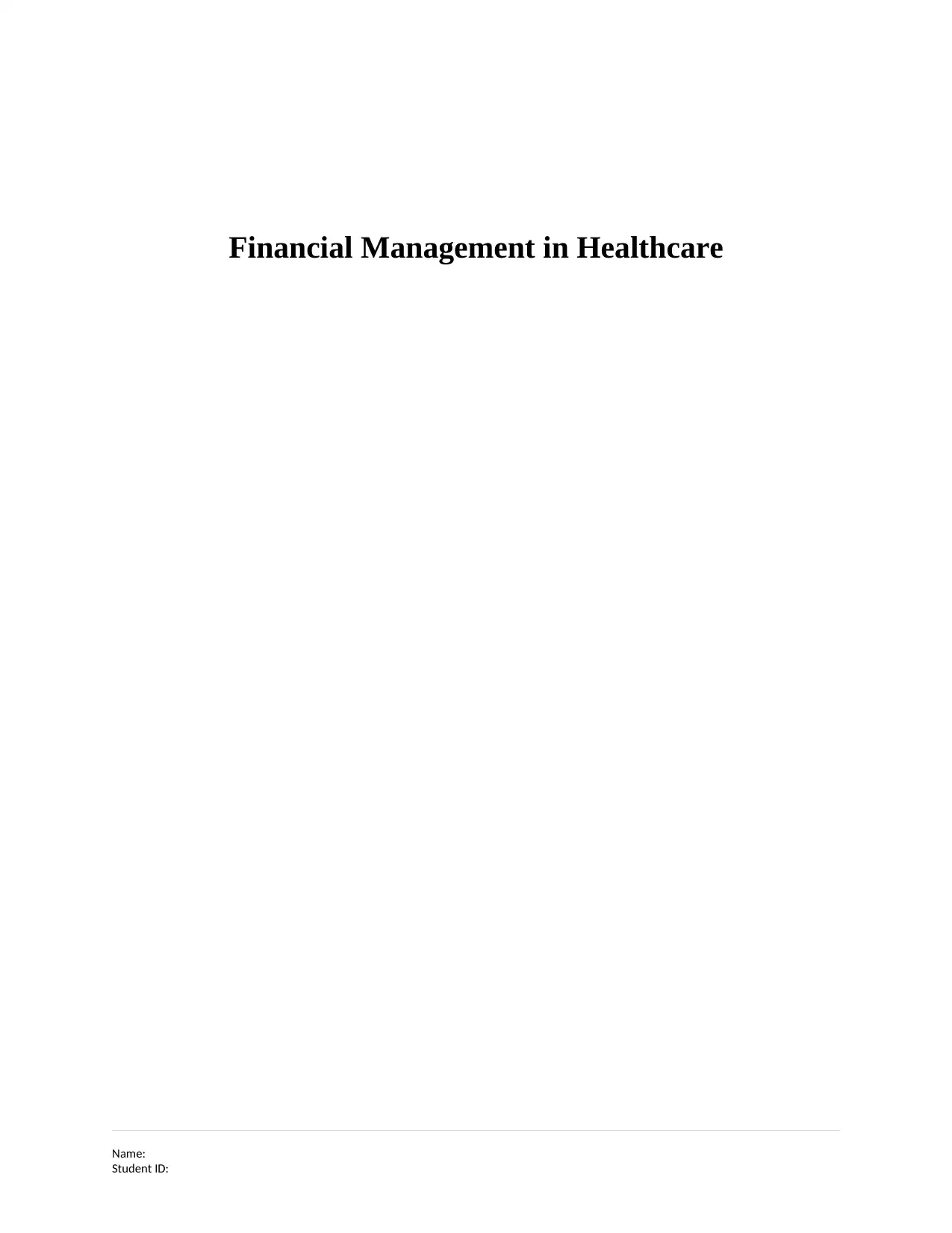
Financial Management in Healthcare
Name:
Student ID:
Name:
Student ID:
Secure Best Marks with AI Grader
Need help grading? Try our AI Grader for instant feedback on your assignments.
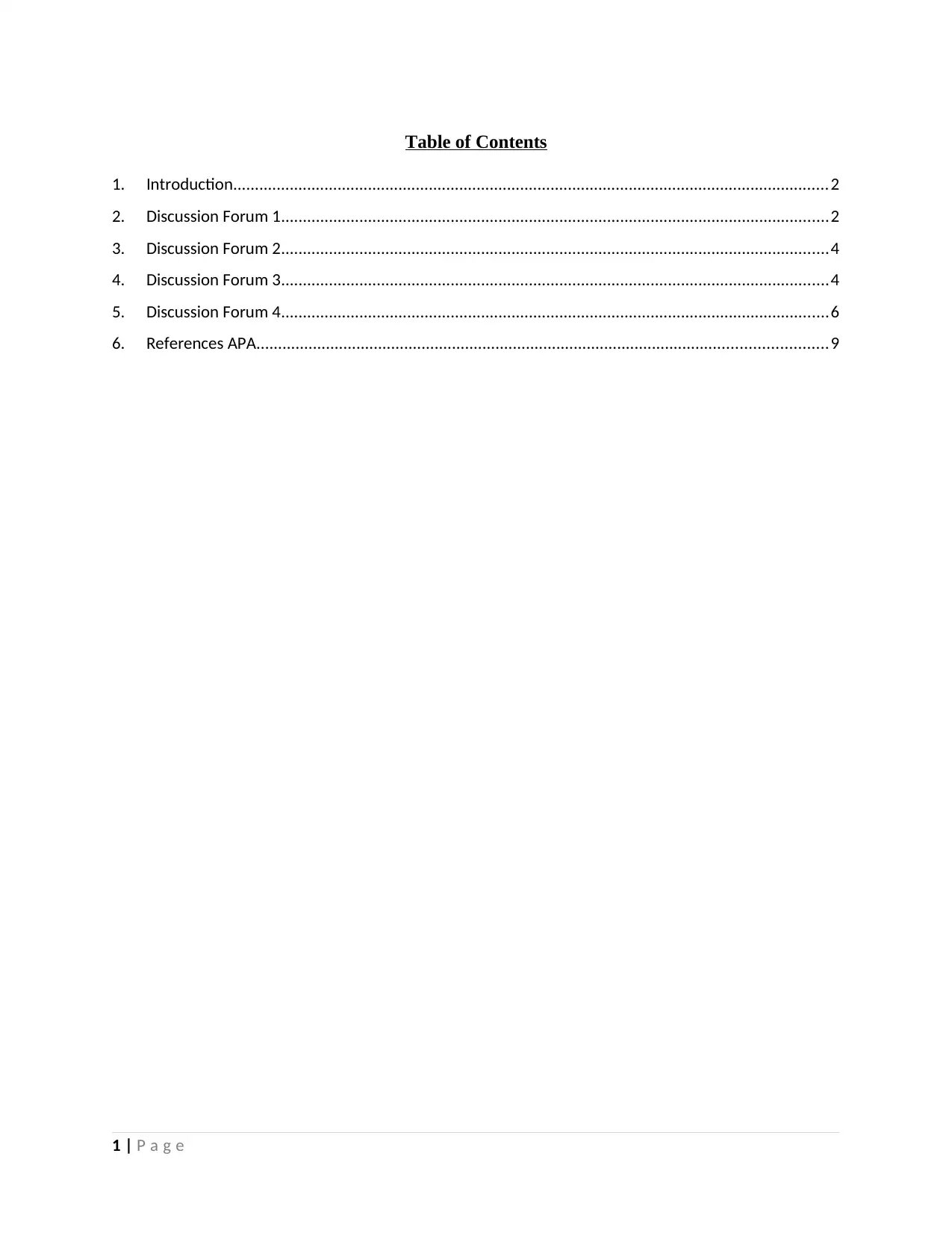
Table of Contents
1. Introduction.........................................................................................................................................2
2. Discussion Forum 1..............................................................................................................................2
3. Discussion Forum 2..............................................................................................................................4
4. Discussion Forum 3..............................................................................................................................4
5. Discussion Forum 4..............................................................................................................................6
6. References APA...................................................................................................................................9
1 | P a g e
1. Introduction.........................................................................................................................................2
2. Discussion Forum 1..............................................................................................................................2
3. Discussion Forum 2..............................................................................................................................4
4. Discussion Forum 3..............................................................................................................................4
5. Discussion Forum 4..............................................................................................................................6
6. References APA...................................................................................................................................9
1 | P a g e
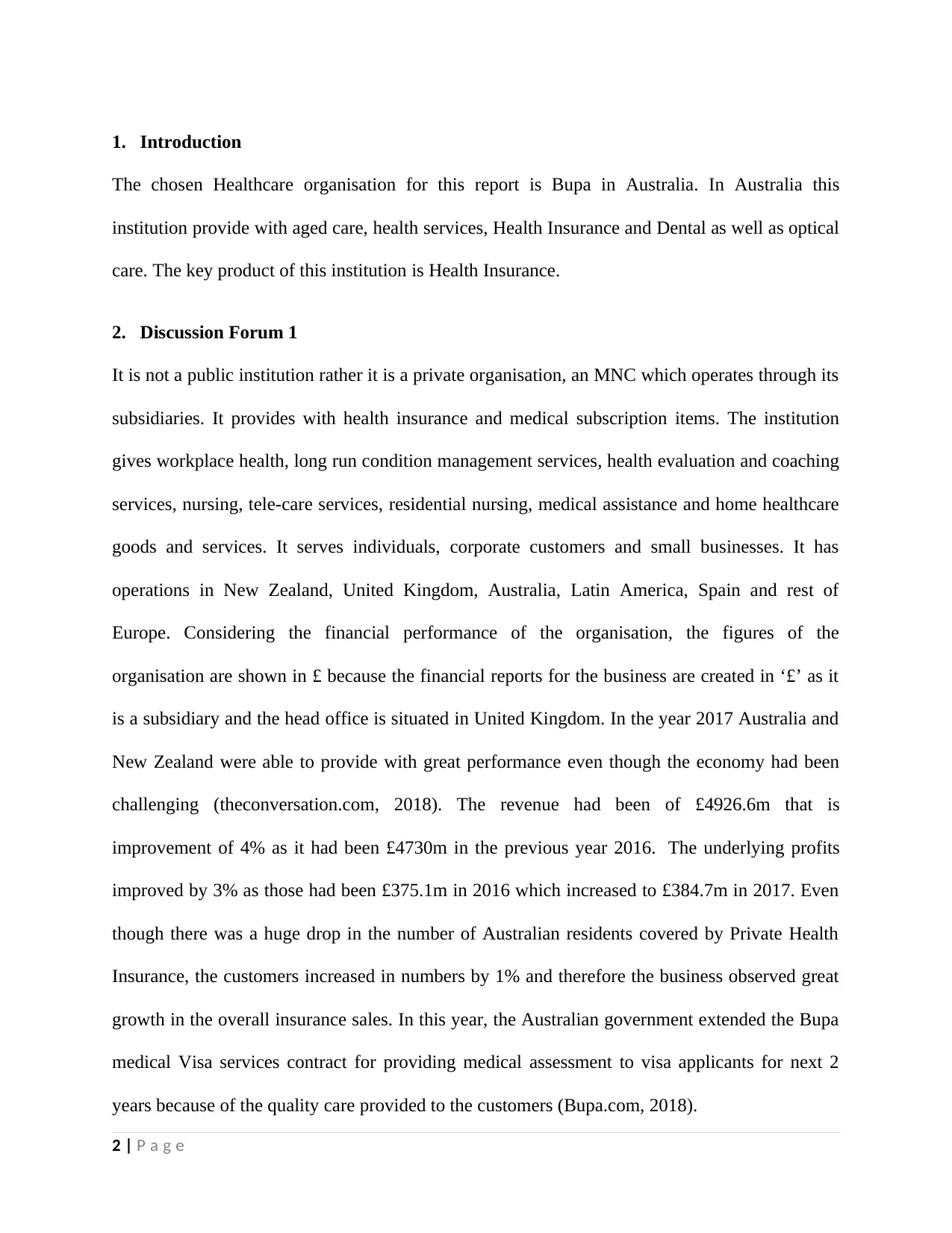
1. Introduction
The chosen Healthcare organisation for this report is Bupa in Australia. In Australia this
institution provide with aged care, health services, Health Insurance and Dental as well as optical
care. The key product of this institution is Health Insurance.
2. Discussion Forum 1
It is not a public institution rather it is a private organisation, an MNC which operates through its
subsidiaries. It provides with health insurance and medical subscription items. The institution
gives workplace health, long run condition management services, health evaluation and coaching
services, nursing, tele-care services, residential nursing, medical assistance and home healthcare
goods and services. It serves individuals, corporate customers and small businesses. It has
operations in New Zealand, United Kingdom, Australia, Latin America, Spain and rest of
Europe. Considering the financial performance of the organisation, the figures of the
organisation are shown in £ because the financial reports for the business are created in ‘£’ as it
is a subsidiary and the head office is situated in United Kingdom. In the year 2017 Australia and
New Zealand were able to provide with great performance even though the economy had been
challenging (theconversation.com, 2018). The revenue had been of £4926.6m that is
improvement of 4% as it had been £4730m in the previous year 2016. The underlying profits
improved by 3% as those had been £375.1m in 2016 which increased to £384.7m in 2017. Even
though there was a huge drop in the number of Australian residents covered by Private Health
Insurance, the customers increased in numbers by 1% and therefore the business observed great
growth in the overall insurance sales. In this year, the Australian government extended the Bupa
medical Visa services contract for providing medical assessment to visa applicants for next 2
years because of the quality care provided to the customers (Bupa.com, 2018).
2 | P a g e
The chosen Healthcare organisation for this report is Bupa in Australia. In Australia this
institution provide with aged care, health services, Health Insurance and Dental as well as optical
care. The key product of this institution is Health Insurance.
2. Discussion Forum 1
It is not a public institution rather it is a private organisation, an MNC which operates through its
subsidiaries. It provides with health insurance and medical subscription items. The institution
gives workplace health, long run condition management services, health evaluation and coaching
services, nursing, tele-care services, residential nursing, medical assistance and home healthcare
goods and services. It serves individuals, corporate customers and small businesses. It has
operations in New Zealand, United Kingdom, Australia, Latin America, Spain and rest of
Europe. Considering the financial performance of the organisation, the figures of the
organisation are shown in £ because the financial reports for the business are created in ‘£’ as it
is a subsidiary and the head office is situated in United Kingdom. In the year 2017 Australia and
New Zealand were able to provide with great performance even though the economy had been
challenging (theconversation.com, 2018). The revenue had been of £4926.6m that is
improvement of 4% as it had been £4730m in the previous year 2016. The underlying profits
improved by 3% as those had been £375.1m in 2016 which increased to £384.7m in 2017. Even
though there was a huge drop in the number of Australian residents covered by Private Health
Insurance, the customers increased in numbers by 1% and therefore the business observed great
growth in the overall insurance sales. In this year, the Australian government extended the Bupa
medical Visa services contract for providing medical assessment to visa applicants for next 2
years because of the quality care provided to the customers (Bupa.com, 2018).
2 | P a g e
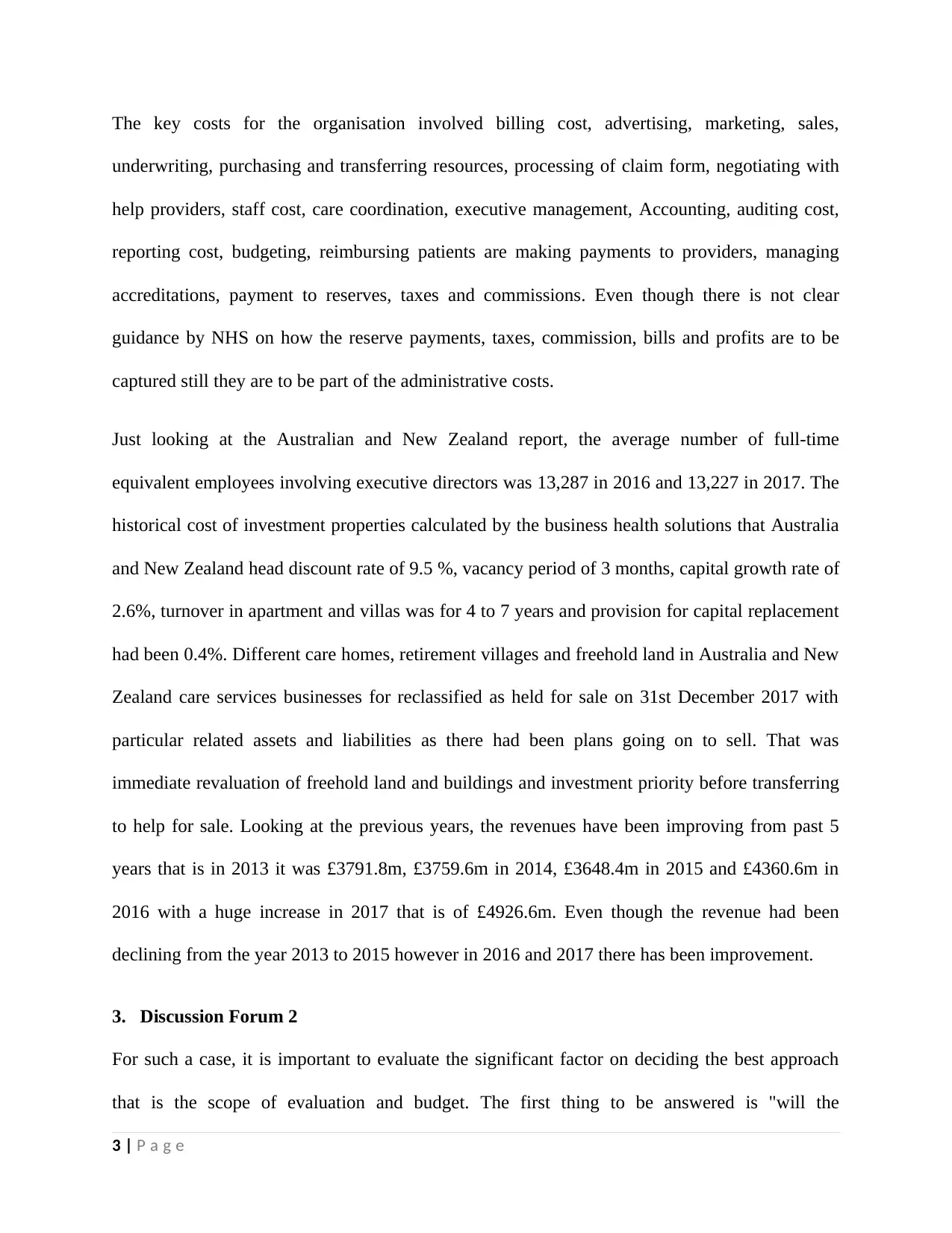
The key costs for the organisation involved billing cost, advertising, marketing, sales,
underwriting, purchasing and transferring resources, processing of claim form, negotiating with
help providers, staff cost, care coordination, executive management, Accounting, auditing cost,
reporting cost, budgeting, reimbursing patients are making payments to providers, managing
accreditations, payment to reserves, taxes and commissions. Even though there is not clear
guidance by NHS on how the reserve payments, taxes, commission, bills and profits are to be
captured still they are to be part of the administrative costs.
Just looking at the Australian and New Zealand report, the average number of full-time
equivalent employees involving executive directors was 13,287 in 2016 and 13,227 in 2017. The
historical cost of investment properties calculated by the business health solutions that Australia
and New Zealand head discount rate of 9.5 %, vacancy period of 3 months, capital growth rate of
2.6%, turnover in apartment and villas was for 4 to 7 years and provision for capital replacement
had been 0.4%. Different care homes, retirement villages and freehold land in Australia and New
Zealand care services businesses for reclassified as held for sale on 31st December 2017 with
particular related assets and liabilities as there had been plans going on to sell. That was
immediate revaluation of freehold land and buildings and investment priority before transferring
to help for sale. Looking at the previous years, the revenues have been improving from past 5
years that is in 2013 it was £3791.8m, £3759.6m in 2014, £3648.4m in 2015 and £4360.6m in
2016 with a huge increase in 2017 that is of £4926.6m. Even though the revenue had been
declining from the year 2013 to 2015 however in 2016 and 2017 there has been improvement.
3. Discussion Forum 2
For such a case, it is important to evaluate the significant factor on deciding the best approach
that is the scope of evaluation and budget. The first thing to be answered is "will the
3 | P a g e
underwriting, purchasing and transferring resources, processing of claim form, negotiating with
help providers, staff cost, care coordination, executive management, Accounting, auditing cost,
reporting cost, budgeting, reimbursing patients are making payments to providers, managing
accreditations, payment to reserves, taxes and commissions. Even though there is not clear
guidance by NHS on how the reserve payments, taxes, commission, bills and profits are to be
captured still they are to be part of the administrative costs.
Just looking at the Australian and New Zealand report, the average number of full-time
equivalent employees involving executive directors was 13,287 in 2016 and 13,227 in 2017. The
historical cost of investment properties calculated by the business health solutions that Australia
and New Zealand head discount rate of 9.5 %, vacancy period of 3 months, capital growth rate of
2.6%, turnover in apartment and villas was for 4 to 7 years and provision for capital replacement
had been 0.4%. Different care homes, retirement villages and freehold land in Australia and New
Zealand care services businesses for reclassified as held for sale on 31st December 2017 with
particular related assets and liabilities as there had been plans going on to sell. That was
immediate revaluation of freehold land and buildings and investment priority before transferring
to help for sale. Looking at the previous years, the revenues have been improving from past 5
years that is in 2013 it was £3791.8m, £3759.6m in 2014, £3648.4m in 2015 and £4360.6m in
2016 with a huge increase in 2017 that is of £4926.6m. Even though the revenue had been
declining from the year 2013 to 2015 however in 2016 and 2017 there has been improvement.
3. Discussion Forum 2
For such a case, it is important to evaluate the significant factor on deciding the best approach
that is the scope of evaluation and budget. The first thing to be answered is "will the
3 | P a g e
Secure Best Marks with AI Grader
Need help grading? Try our AI Grader for instant feedback on your assignments.
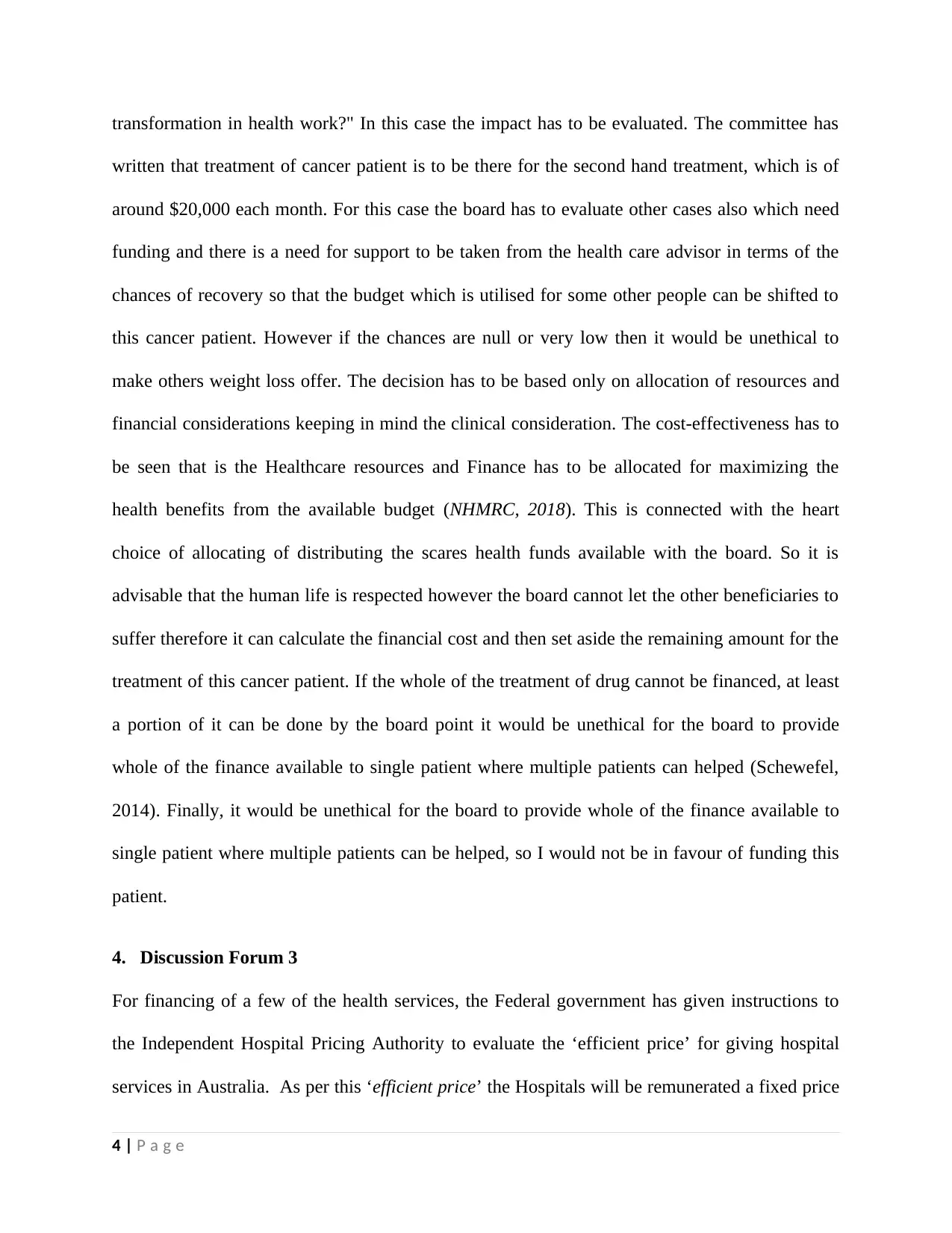
transformation in health work?" In this case the impact has to be evaluated. The committee has
written that treatment of cancer patient is to be there for the second hand treatment, which is of
around $20,000 each month. For this case the board has to evaluate other cases also which need
funding and there is a need for support to be taken from the health care advisor in terms of the
chances of recovery so that the budget which is utilised for some other people can be shifted to
this cancer patient. However if the chances are null or very low then it would be unethical to
make others weight loss offer. The decision has to be based only on allocation of resources and
financial considerations keeping in mind the clinical consideration. The cost-effectiveness has to
be seen that is the Healthcare resources and Finance has to be allocated for maximizing the
health benefits from the available budget (NHMRC, 2018). This is connected with the heart
choice of allocating of distributing the scares health funds available with the board. So it is
advisable that the human life is respected however the board cannot let the other beneficiaries to
suffer therefore it can calculate the financial cost and then set aside the remaining amount for the
treatment of this cancer patient. If the whole of the treatment of drug cannot be financed, at least
a portion of it can be done by the board point it would be unethical for the board to provide
whole of the finance available to single patient where multiple patients can helped (Schewefel,
2014). Finally, it would be unethical for the board to provide whole of the finance available to
single patient where multiple patients can be helped, so I would not be in favour of funding this
patient.
4. Discussion Forum 3
For financing of a few of the health services, the Federal government has given instructions to
the Independent Hospital Pricing Authority to evaluate the ‘efficient price’ for giving hospital
services in Australia. As per this ‘efficient price’ the Hospitals will be remunerated a fixed price
4 | P a g e
written that treatment of cancer patient is to be there for the second hand treatment, which is of
around $20,000 each month. For this case the board has to evaluate other cases also which need
funding and there is a need for support to be taken from the health care advisor in terms of the
chances of recovery so that the budget which is utilised for some other people can be shifted to
this cancer patient. However if the chances are null or very low then it would be unethical to
make others weight loss offer. The decision has to be based only on allocation of resources and
financial considerations keeping in mind the clinical consideration. The cost-effectiveness has to
be seen that is the Healthcare resources and Finance has to be allocated for maximizing the
health benefits from the available budget (NHMRC, 2018). This is connected with the heart
choice of allocating of distributing the scares health funds available with the board. So it is
advisable that the human life is respected however the board cannot let the other beneficiaries to
suffer therefore it can calculate the financial cost and then set aside the remaining amount for the
treatment of this cancer patient. If the whole of the treatment of drug cannot be financed, at least
a portion of it can be done by the board point it would be unethical for the board to provide
whole of the finance available to single patient where multiple patients can helped (Schewefel,
2014). Finally, it would be unethical for the board to provide whole of the finance available to
single patient where multiple patients can be helped, so I would not be in favour of funding this
patient.
4. Discussion Forum 3
For financing of a few of the health services, the Federal government has given instructions to
the Independent Hospital Pricing Authority to evaluate the ‘efficient price’ for giving hospital
services in Australia. As per this ‘efficient price’ the Hospitals will be remunerated a fixed price
4 | P a g e
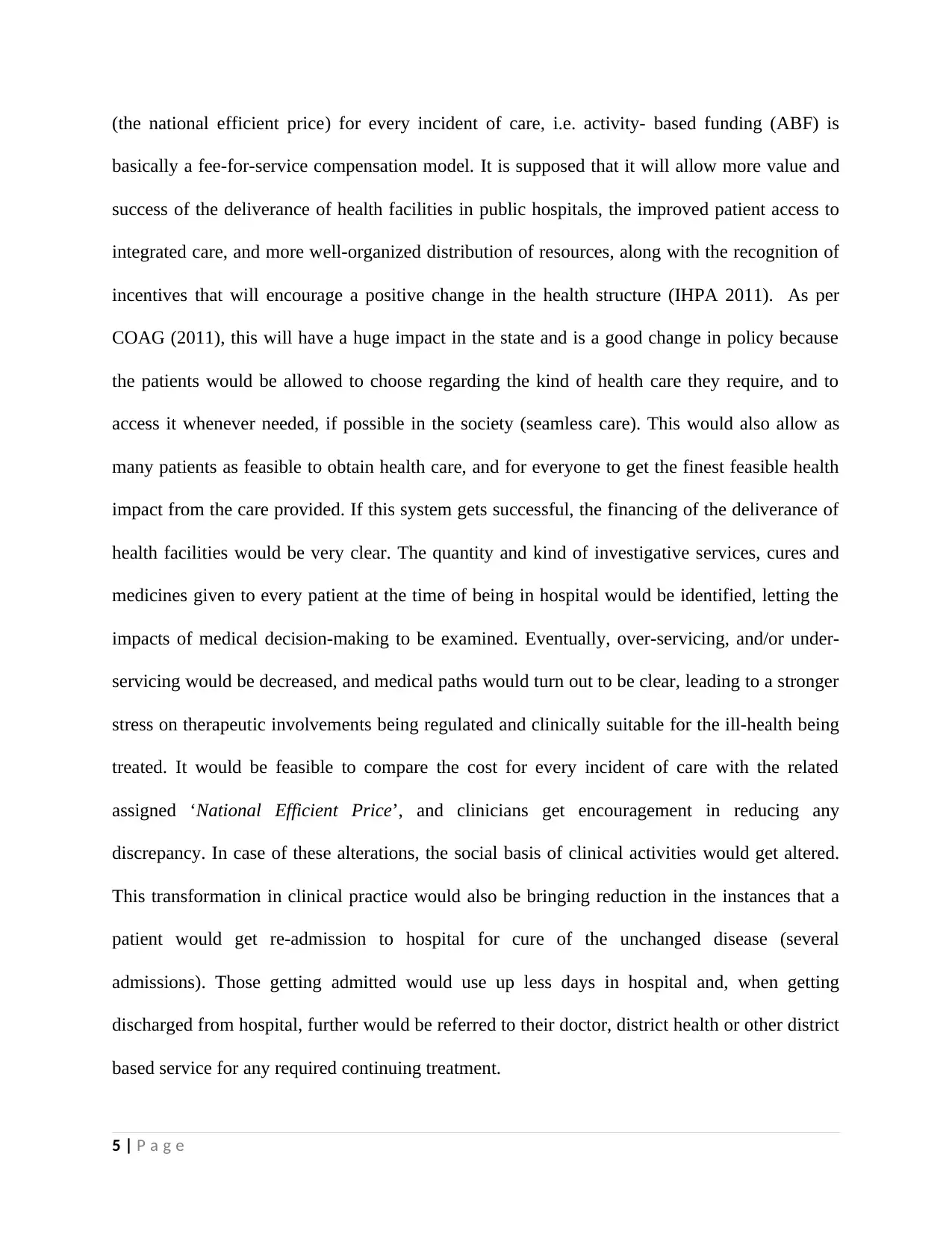
(the national efficient price) for every incident of care, i.e. activity- based funding (ABF) is
basically a fee-for-service compensation model. It is supposed that it will allow more value and
success of the deliverance of health facilities in public hospitals, the improved patient access to
integrated care, and more well-organized distribution of resources, along with the recognition of
incentives that will encourage a positive change in the health structure (IHPA 2011). As per
COAG (2011), this will have a huge impact in the state and is a good change in policy because
the patients would be allowed to choose regarding the kind of health care they require, and to
access it whenever needed, if possible in the society (seamless care). This would also allow as
many patients as feasible to obtain health care, and for everyone to get the finest feasible health
impact from the care provided. If this system gets successful, the financing of the deliverance of
health facilities would be very clear. The quantity and kind of investigative services, cures and
medicines given to every patient at the time of being in hospital would be identified, letting the
impacts of medical decision-making to be examined. Eventually, over-servicing, and/or under-
servicing would be decreased, and medical paths would turn out to be clear, leading to a stronger
stress on therapeutic involvements being regulated and clinically suitable for the ill-health being
treated. It would be feasible to compare the cost for every incident of care with the related
assigned ‘National Efficient Price’, and clinicians get encouragement in reducing any
discrepancy. In case of these alterations, the social basis of clinical activities would get altered.
This transformation in clinical practice would also be bringing reduction in the instances that a
patient would get re-admission to hospital for cure of the unchanged disease (several
admissions). Those getting admitted would use up less days in hospital and, when getting
discharged from hospital, further would be referred to their doctor, district health or other district
based service for any required continuing treatment.
5 | P a g e
basically a fee-for-service compensation model. It is supposed that it will allow more value and
success of the deliverance of health facilities in public hospitals, the improved patient access to
integrated care, and more well-organized distribution of resources, along with the recognition of
incentives that will encourage a positive change in the health structure (IHPA 2011). As per
COAG (2011), this will have a huge impact in the state and is a good change in policy because
the patients would be allowed to choose regarding the kind of health care they require, and to
access it whenever needed, if possible in the society (seamless care). This would also allow as
many patients as feasible to obtain health care, and for everyone to get the finest feasible health
impact from the care provided. If this system gets successful, the financing of the deliverance of
health facilities would be very clear. The quantity and kind of investigative services, cures and
medicines given to every patient at the time of being in hospital would be identified, letting the
impacts of medical decision-making to be examined. Eventually, over-servicing, and/or under-
servicing would be decreased, and medical paths would turn out to be clear, leading to a stronger
stress on therapeutic involvements being regulated and clinically suitable for the ill-health being
treated. It would be feasible to compare the cost for every incident of care with the related
assigned ‘National Efficient Price’, and clinicians get encouragement in reducing any
discrepancy. In case of these alterations, the social basis of clinical activities would get altered.
This transformation in clinical practice would also be bringing reduction in the instances that a
patient would get re-admission to hospital for cure of the unchanged disease (several
admissions). Those getting admitted would use up less days in hospital and, when getting
discharged from hospital, further would be referred to their doctor, district health or other district
based service for any required continuing treatment.
5 | P a g e
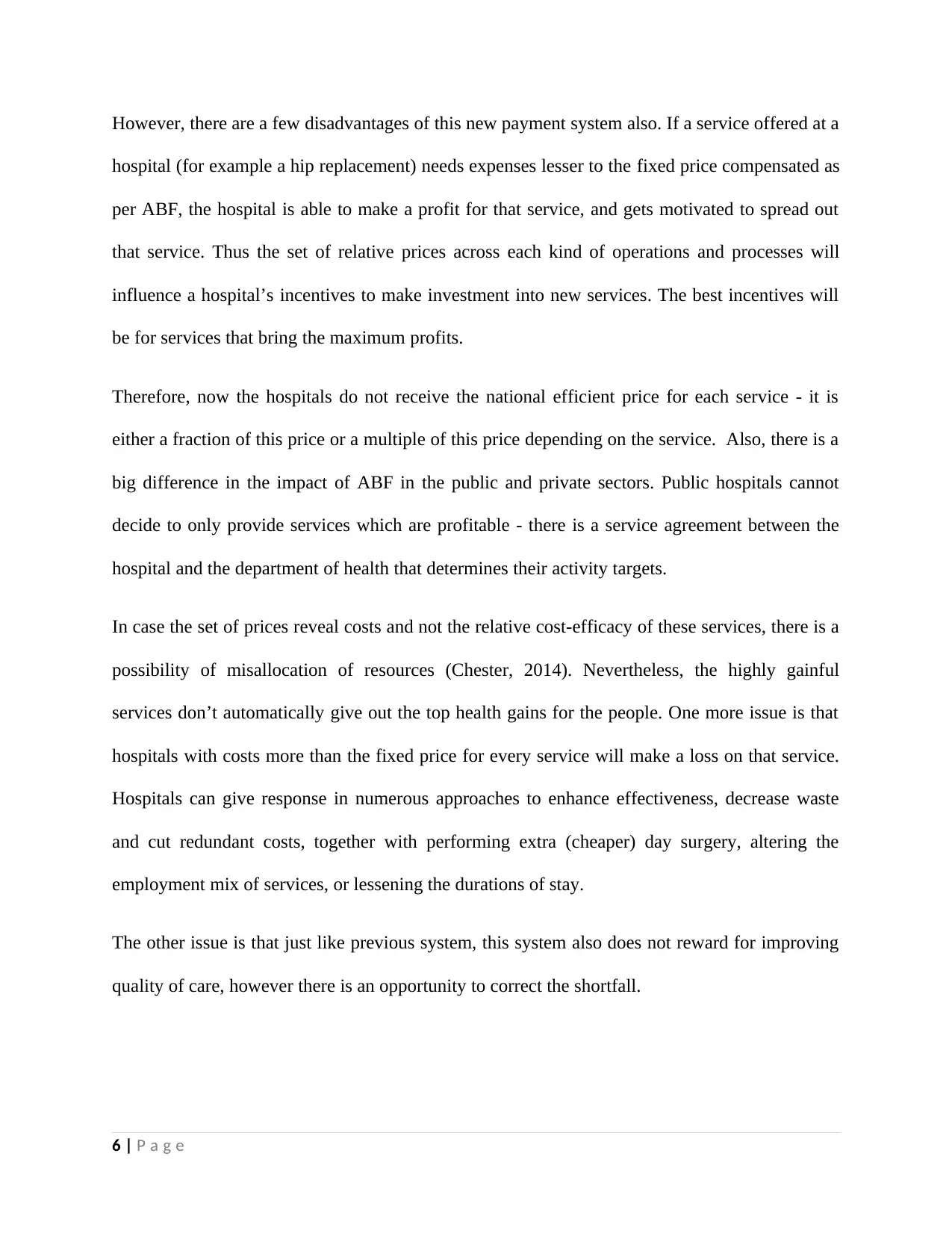
However, there are a few disadvantages of this new payment system also. If a service offered at a
hospital (for example a hip replacement) needs expenses lesser to the fixed price compensated as
per ABF, the hospital is able to make a profit for that service, and gets motivated to spread out
that service. Thus the set of relative prices across each kind of operations and processes will
influence a hospital’s incentives to make investment into new services. The best incentives will
be for services that bring the maximum profits.
Therefore, now the hospitals do not receive the national efficient price for each service - it is
either a fraction of this price or a multiple of this price depending on the service. Also, there is a
big difference in the impact of ABF in the public and private sectors. Public hospitals cannot
decide to only provide services which are profitable - there is a service agreement between the
hospital and the department of health that determines their activity targets.
In case the set of prices reveal costs and not the relative cost-efficacy of these services, there is a
possibility of misallocation of resources (Chester, 2014). Nevertheless, the highly gainful
services don’t automatically give out the top health gains for the people. One more issue is that
hospitals with costs more than the fixed price for every service will make a loss on that service.
Hospitals can give response in numerous approaches to enhance effectiveness, decrease waste
and cut redundant costs, together with performing extra (cheaper) day surgery, altering the
employment mix of services, or lessening the durations of stay.
The other issue is that just like previous system, this system also does not reward for improving
quality of care, however there is an opportunity to correct the shortfall.
6 | P a g e
hospital (for example a hip replacement) needs expenses lesser to the fixed price compensated as
per ABF, the hospital is able to make a profit for that service, and gets motivated to spread out
that service. Thus the set of relative prices across each kind of operations and processes will
influence a hospital’s incentives to make investment into new services. The best incentives will
be for services that bring the maximum profits.
Therefore, now the hospitals do not receive the national efficient price for each service - it is
either a fraction of this price or a multiple of this price depending on the service. Also, there is a
big difference in the impact of ABF in the public and private sectors. Public hospitals cannot
decide to only provide services which are profitable - there is a service agreement between the
hospital and the department of health that determines their activity targets.
In case the set of prices reveal costs and not the relative cost-efficacy of these services, there is a
possibility of misallocation of resources (Chester, 2014). Nevertheless, the highly gainful
services don’t automatically give out the top health gains for the people. One more issue is that
hospitals with costs more than the fixed price for every service will make a loss on that service.
Hospitals can give response in numerous approaches to enhance effectiveness, decrease waste
and cut redundant costs, together with performing extra (cheaper) day surgery, altering the
employment mix of services, or lessening the durations of stay.
The other issue is that just like previous system, this system also does not reward for improving
quality of care, however there is an opportunity to correct the shortfall.
6 | P a g e
Paraphrase This Document
Need a fresh take? Get an instant paraphrase of this document with our AI Paraphraser
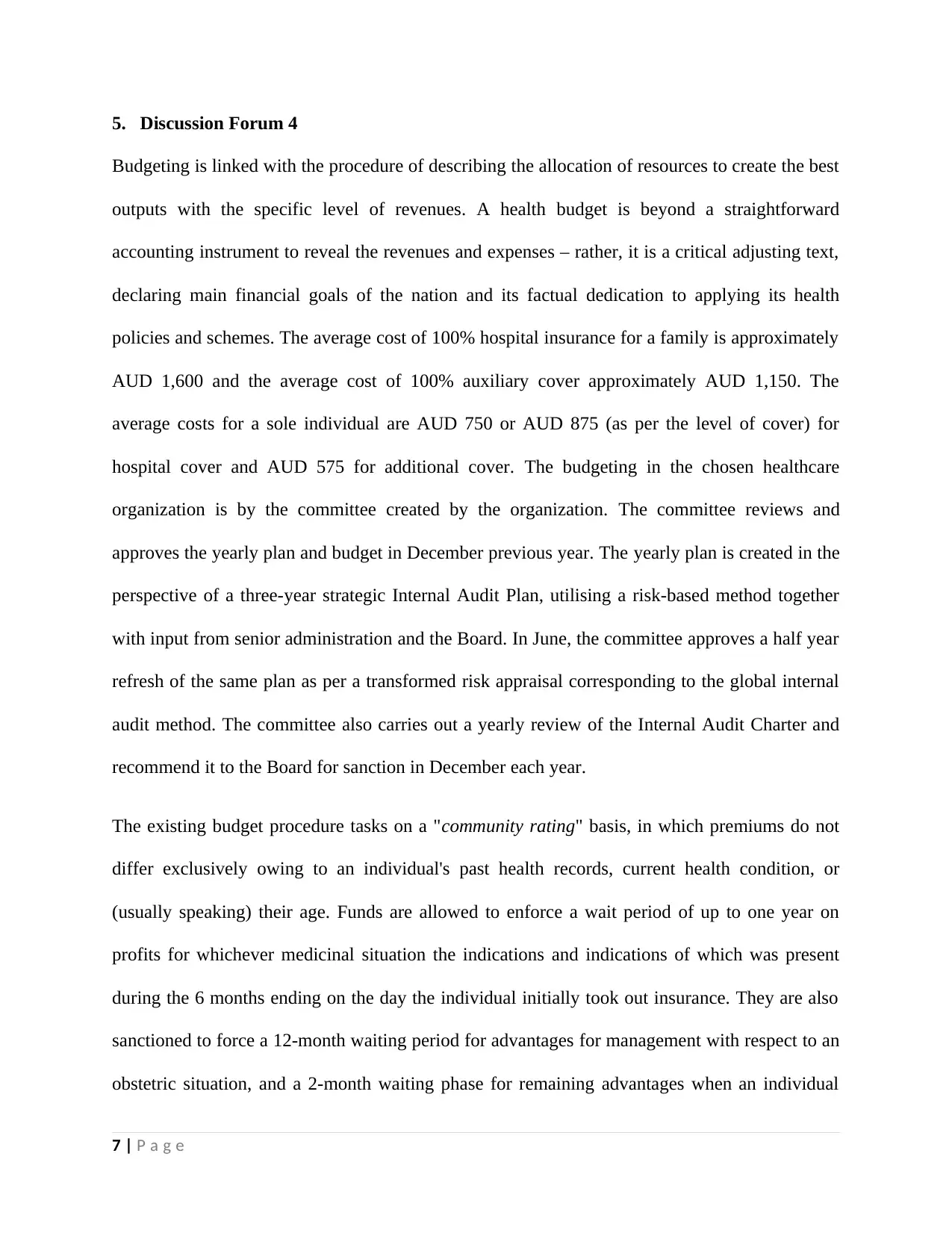
5. Discussion Forum 4
Budgeting is linked with the procedure of describing the allocation of resources to create the best
outputs with the specific level of revenues. A health budget is beyond a straightforward
accounting instrument to reveal the revenues and expenses – rather, it is a critical adjusting text,
declaring main financial goals of the nation and its factual dedication to applying its health
policies and schemes. The average cost of 100% hospital insurance for a family is approximately
AUD 1,600 and the average cost of 100% auxiliary cover approximately AUD 1,150. The
average costs for a sole individual are AUD 750 or AUD 875 (as per the level of cover) for
hospital cover and AUD 575 for additional cover. The budgeting in the chosen healthcare
organization is by the committee created by the organization. The committee reviews and
approves the yearly plan and budget in December previous year. The yearly plan is created in the
perspective of a three-year strategic Internal Audit Plan, utilising a risk-based method together
with input from senior administration and the Board. In June, the committee approves a half year
refresh of the same plan as per a transformed risk appraisal corresponding to the global internal
audit method. The committee also carries out a yearly review of the Internal Audit Charter and
recommend it to the Board for sanction in December each year.
The existing budget procedure tasks on a "community rating" basis, in which premiums do not
differ exclusively owing to an individual's past health records, current health condition, or
(usually speaking) their age. Funds are allowed to enforce a wait period of up to one year on
profits for whichever medicinal situation the indications and indications of which was present
during the 6 months ending on the day the individual initially took out insurance. They are also
sanctioned to force a 12-month waiting period for advantages for management with respect to an
obstetric situation, and a 2-month waiting phase for remaining advantages when an individual
7 | P a g e
Budgeting is linked with the procedure of describing the allocation of resources to create the best
outputs with the specific level of revenues. A health budget is beyond a straightforward
accounting instrument to reveal the revenues and expenses – rather, it is a critical adjusting text,
declaring main financial goals of the nation and its factual dedication to applying its health
policies and schemes. The average cost of 100% hospital insurance for a family is approximately
AUD 1,600 and the average cost of 100% auxiliary cover approximately AUD 1,150. The
average costs for a sole individual are AUD 750 or AUD 875 (as per the level of cover) for
hospital cover and AUD 575 for additional cover. The budgeting in the chosen healthcare
organization is by the committee created by the organization. The committee reviews and
approves the yearly plan and budget in December previous year. The yearly plan is created in the
perspective of a three-year strategic Internal Audit Plan, utilising a risk-based method together
with input from senior administration and the Board. In June, the committee approves a half year
refresh of the same plan as per a transformed risk appraisal corresponding to the global internal
audit method. The committee also carries out a yearly review of the Internal Audit Charter and
recommend it to the Board for sanction in December each year.
The existing budget procedure tasks on a "community rating" basis, in which premiums do not
differ exclusively owing to an individual's past health records, current health condition, or
(usually speaking) their age. Funds are allowed to enforce a wait period of up to one year on
profits for whichever medicinal situation the indications and indications of which was present
during the 6 months ending on the day the individual initially took out insurance. They are also
sanctioned to force a 12-month waiting period for advantages for management with respect to an
obstetric situation, and a 2-month waiting phase for remaining advantages when an individual
7 | P a g e
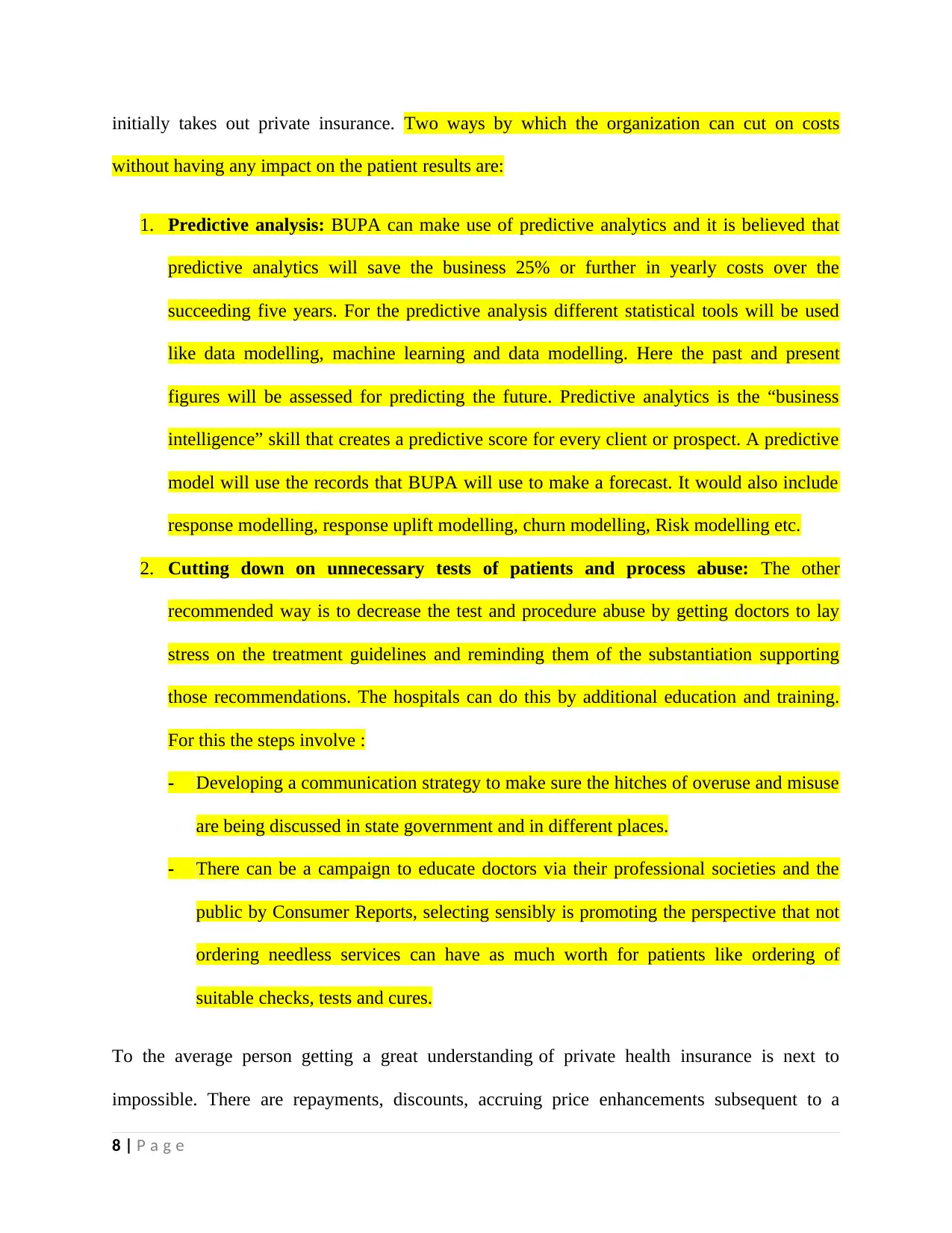
initially takes out private insurance. Two ways by which the organization can cut on costs
without having any impact on the patient results are:
1. Predictive analysis: BUPA can make use of predictive analytics and it is believed that
predictive analytics will save the business 25% or further in yearly costs over the
succeeding five years. For the predictive analysis different statistical tools will be used
like data modelling, machine learning and data modelling. Here the past and present
figures will be assessed for predicting the future. Predictive analytics is the “business
intelligence” skill that creates a predictive score for every client or prospect. A predictive
model will use the records that BUPA will use to make a forecast. It would also include
response modelling, response uplift modelling, churn modelling, Risk modelling etc.
2. Cutting down on unnecessary tests of patients and process abuse: The other
recommended way is to decrease the test and procedure abuse by getting doctors to lay
stress on the treatment guidelines and reminding them of the substantiation supporting
those recommendations. The hospitals can do this by additional education and training.
For this the steps involve :
- Developing a communication strategy to make sure the hitches of overuse and misuse
are being discussed in state government and in different places.
- There can be a campaign to educate doctors via their professional societies and the
public by Consumer Reports, selecting sensibly is promoting the perspective that not
ordering needless services can have as much worth for patients like ordering of
suitable checks, tests and cures.
To the average person getting a great understanding of private health insurance is next to
impossible. There are repayments, discounts, accruing price enhancements subsequent to a
8 | P a g e
without having any impact on the patient results are:
1. Predictive analysis: BUPA can make use of predictive analytics and it is believed that
predictive analytics will save the business 25% or further in yearly costs over the
succeeding five years. For the predictive analysis different statistical tools will be used
like data modelling, machine learning and data modelling. Here the past and present
figures will be assessed for predicting the future. Predictive analytics is the “business
intelligence” skill that creates a predictive score for every client or prospect. A predictive
model will use the records that BUPA will use to make a forecast. It would also include
response modelling, response uplift modelling, churn modelling, Risk modelling etc.
2. Cutting down on unnecessary tests of patients and process abuse: The other
recommended way is to decrease the test and procedure abuse by getting doctors to lay
stress on the treatment guidelines and reminding them of the substantiation supporting
those recommendations. The hospitals can do this by additional education and training.
For this the steps involve :
- Developing a communication strategy to make sure the hitches of overuse and misuse
are being discussed in state government and in different places.
- There can be a campaign to educate doctors via their professional societies and the
public by Consumer Reports, selecting sensibly is promoting the perspective that not
ordering needless services can have as much worth for patients like ordering of
suitable checks, tests and cures.
To the average person getting a great understanding of private health insurance is next to
impossible. There are repayments, discounts, accruing price enhancements subsequent to a
8 | P a g e
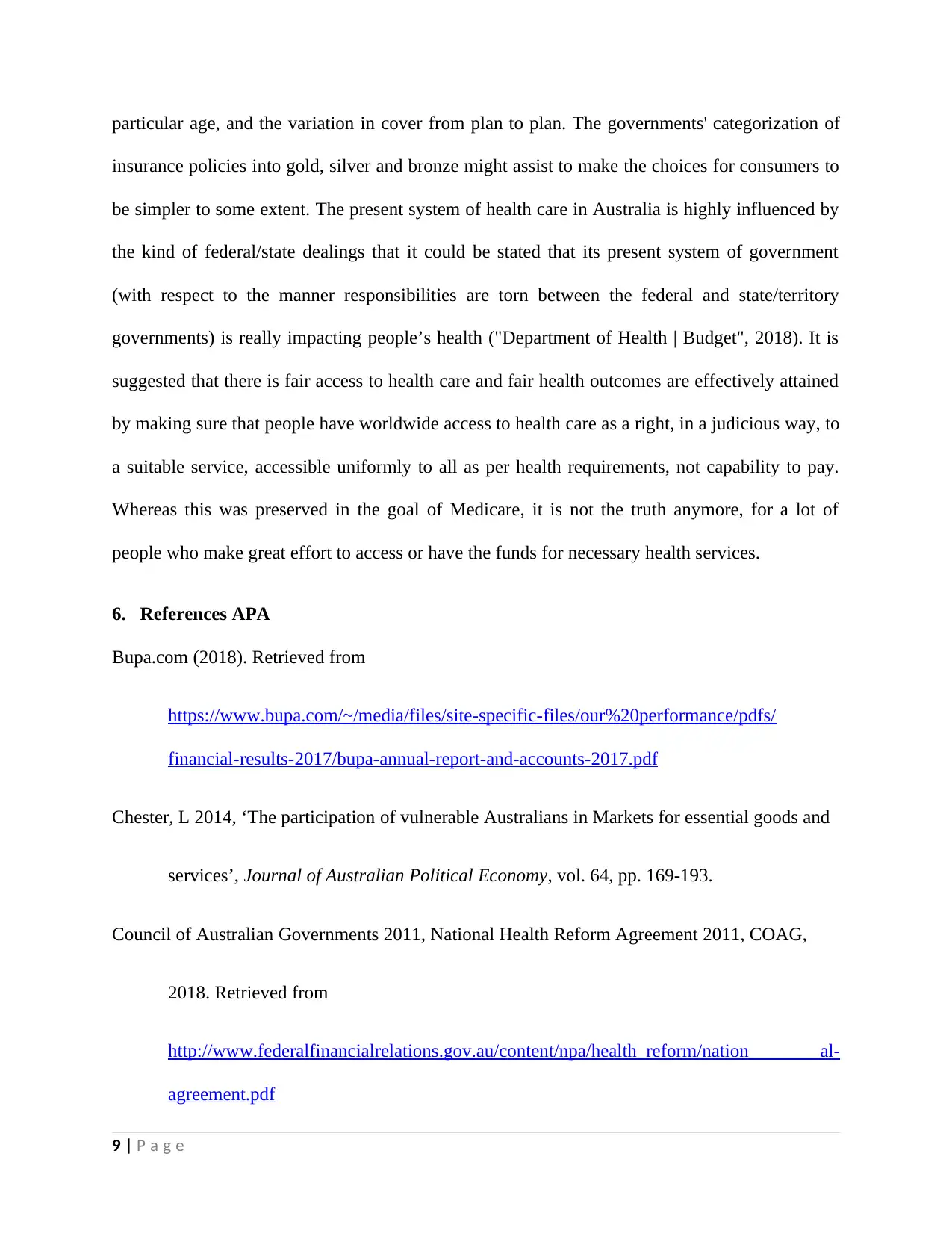
particular age, and the variation in cover from plan to plan. The governments' categorization of
insurance policies into gold, silver and bronze might assist to make the choices for consumers to
be simpler to some extent. The present system of health care in Australia is highly influenced by
the kind of federal/state dealings that it could be stated that its present system of government
(with respect to the manner responsibilities are torn between the federal and state/territory
governments) is really impacting people’s health ("Department of Health | Budget", 2018). It is
suggested that there is fair access to health care and fair health outcomes are effectively attained
by making sure that people have worldwide access to health care as a right, in a judicious way, to
a suitable service, accessible uniformly to all as per health requirements, not capability to pay.
Whereas this was preserved in the goal of Medicare, it is not the truth anymore, for a lot of
people who make great effort to access or have the funds for necessary health services.
6. References APA
Bupa.com (2018). Retrieved from
https://www.bupa.com/~/media/files/site-specific-files/our%20performance/pdfs/
financial-results-2017/bupa-annual-report-and-accounts-2017.pdf
Chester, L 2014, ‘The participation of vulnerable Australians in Markets for essential goods and
services’, Journal of Australian Political Economy, vol. 64, pp. 169-193.
Council of Australian Governments 2011, National Health Reform Agreement 2011, COAG,
2018. Retrieved from
http://www.federalfinancialrelations.gov.au/content/npa/health_reform/nation al-
agreement.pdf
9 | P a g e
insurance policies into gold, silver and bronze might assist to make the choices for consumers to
be simpler to some extent. The present system of health care in Australia is highly influenced by
the kind of federal/state dealings that it could be stated that its present system of government
(with respect to the manner responsibilities are torn between the federal and state/territory
governments) is really impacting people’s health ("Department of Health | Budget", 2018). It is
suggested that there is fair access to health care and fair health outcomes are effectively attained
by making sure that people have worldwide access to health care as a right, in a judicious way, to
a suitable service, accessible uniformly to all as per health requirements, not capability to pay.
Whereas this was preserved in the goal of Medicare, it is not the truth anymore, for a lot of
people who make great effort to access or have the funds for necessary health services.
6. References APA
Bupa.com (2018). Retrieved from
https://www.bupa.com/~/media/files/site-specific-files/our%20performance/pdfs/
financial-results-2017/bupa-annual-report-and-accounts-2017.pdf
Chester, L 2014, ‘The participation of vulnerable Australians in Markets for essential goods and
services’, Journal of Australian Political Economy, vol. 64, pp. 169-193.
Council of Australian Governments 2011, National Health Reform Agreement 2011, COAG,
2018. Retrieved from
http://www.federalfinancialrelations.gov.au/content/npa/health_reform/nation al-
agreement.pdf
9 | P a g e
Secure Best Marks with AI Grader
Need help grading? Try our AI Grader for instant feedback on your assignments.
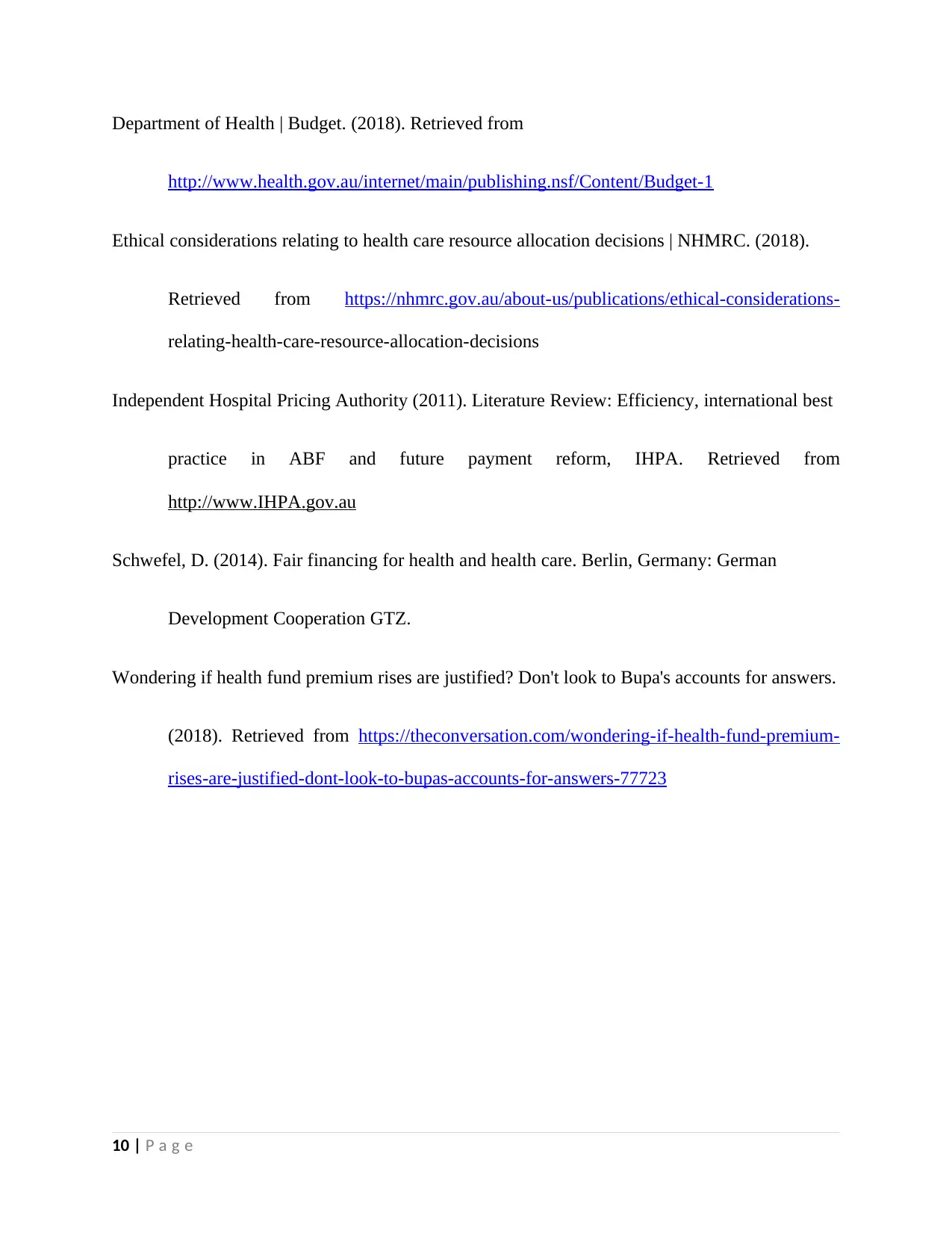
Department of Health | Budget. (2018). Retrieved from
http://www.health.gov.au/internet/main/publishing.nsf/Content/Budget-1
Ethical considerations relating to health care resource allocation decisions | NHMRC. (2018).
Retrieved from https://nhmrc.gov.au/about-us/publications/ethical-considerations-
relating-health-care-resource-allocation-decisions
Independent Hospital Pricing Authority (2011). Literature Review: Efficiency, international best
practice in ABF and future payment reform, IHPA. Retrieved from
http://www.IHPA.gov.au
Schwefel, D. (2014). Fair financing for health and health care. Berlin, Germany: German
Development Cooperation GTZ.
Wondering if health fund premium rises are justified? Don't look to Bupa's accounts for answers.
(2018). Retrieved from https://theconversation.com/wondering-if-health-fund-premium-
rises-are-justified-dont-look-to-bupas-accounts-for-answers-77723
10 | P a g e
http://www.health.gov.au/internet/main/publishing.nsf/Content/Budget-1
Ethical considerations relating to health care resource allocation decisions | NHMRC. (2018).
Retrieved from https://nhmrc.gov.au/about-us/publications/ethical-considerations-
relating-health-care-resource-allocation-decisions
Independent Hospital Pricing Authority (2011). Literature Review: Efficiency, international best
practice in ABF and future payment reform, IHPA. Retrieved from
http://www.IHPA.gov.au
Schwefel, D. (2014). Fair financing for health and health care. Berlin, Germany: German
Development Cooperation GTZ.
Wondering if health fund premium rises are justified? Don't look to Bupa's accounts for answers.
(2018). Retrieved from https://theconversation.com/wondering-if-health-fund-premium-
rises-are-justified-dont-look-to-bupas-accounts-for-answers-77723
10 | P a g e
1 out of 11
Related Documents
Your All-in-One AI-Powered Toolkit for Academic Success.
+13062052269
info@desklib.com
Available 24*7 on WhatsApp / Email
![[object Object]](/_next/static/media/star-bottom.7253800d.svg)
Unlock your academic potential
© 2024 | Zucol Services PVT LTD | All rights reserved.




